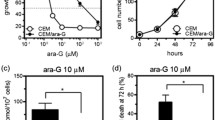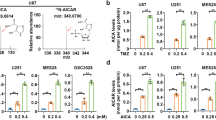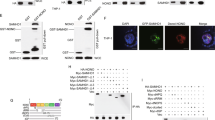Abstract
Chemoresistance is a biological response of cells to survive toxic stress. During cancer treatment the development of chemoresistance is a major problem. The mechanisms how cells become insensitive, and which downstream pathways are affected are not completely understood. Since it has not been well analysed which and how many regulative disorders are subsummised under the term “chemoresistance”, we examined and measured arabinosylcytosine (AraC)-mediated desensitation of two mechanisms relevant for tissue homeostasis, cell cycle inhibition and apoptosis induction. MCF-7 cells harbouring ectopic mutated p53 were suitable for this investigation because they activated these mechanisms subsequently and became insensitive to AraC with regard to cell cycle inhibition and apoptosis induction. The major causal mechanism of acquired resistance against AraC was most likely through the inhibition of the first step of AraC phosphorylation within the cell, which is rate limiting for its activation.
With regard to cell cycle inhibition AraC-resistant cells were also resistant against 5-fluorodeoxyuridine (5-FdUrd), but fully responsive to 5-FdUrd-induced apoptosis, evidencing that cell cycle and apoptosis are independent of each other. Apoptosis correlated with AIF-activation and was independent of Caspase 7, whereas cell cycle inhibition correlated with cyclinD1 expression but not with induction of p21 or p27.
The phosphate conjugated 5-FdUrd-araC heterodimer (5-Fluoro-2′-desoxyuridylyl-(3′→5′)-Arabinocytidine), which is a prodrug of AraC-monophosphate, reactivated AIF and down-regulated cyclin D1 in AraC-resistant cells and circumvented resistance to apoptosis and to cell cycle inhibition. Also, cells which were resistant to 5-FdUrd or doxorubicin were sensitive to 5-FdUrd-araC. This investigation demonstrates that chemoresistance affects apoptosis induction and cell cycle inhibition independently and that detailed knowledge about the affected downstream pathways would enable the design of targeted intervention with small molecules to restore chemosensitivity.
Similar content being viewed by others
Abbreviations
- AIF::
-
Apoptosis Inducing Factor
- AraC::
-
1-β-D-arabinofuranosylcytosine
- 5-FdUrd::
-
2′-deoxy-5-fluorodeoxyuridine
- HOPI::
-
Hoechst 33258/propidium iodide double staining
- mtp53::
-
mutated p53 tumour suppressor DNA
- rAraC., rDox., rFdU::
-
resistance against AraC, doxorubicin, 5-FdUrd.
References
Momparler RL. A model for the chemotherapy of acute leukemia with 1-beta-D- arabinofuranosylcytosine. Cancer Res 1974; 34(8): 1775–1787.
Early AP, Preisler HD, Slocum H, Rustum YM. A pilot study of high-dose 1-beta-D-arabinofuranosylcytosine for acute leukemia and refractory lymphoma: clinical response and pharmacology. Cancer Res 1982; 42(4): 1587–94.
Saiko P, Horvath Z, Illmer C, Madlener S, et al. Cytotoxic effects of novel amphiphilic dimers consisting of 5-fluorodeoxyuridine and arabinofuranosylcytosine in cross-resistant H9 human lymphoma cells. Leuk Res 2005; 29(7): 785–791.
Blum JL, Jones SE, Buzdar AU, et al. Multicenter phase II study of capecitabine in paclitaxel-refractory metastatic breast cancer. J Clin Oncol 1999; 17(2): 485–493.
Talbot DC, Moiseyenko V, Van Belle S, et al. Randomised, phase II trial comparing oral capecitabine (Xeloda) with paclitaxel in patients with metastatic/advanced breast cancer pretreated with anthracyclines. Br J Cancer 2002; 86(9): 1367–1372.
Oshaughnessy JA, Blum J, Moiseyenko V, et al. Randomized, open-label, phase II trial of oral capecitabine (Xeloda) vs. a reference arm of intravenous CMF (cyclophosphamide, methotrexate and 5-fluorouracil) as first-line therapy for advanced/metastatic breast cancer. Ann Oncol 2001; 12(9): 1247–1254.
Saiko P, Horvath Z, Bauer W, et al. In vitro and in vivo antitumor activity of novel amphiphilic dimers consisting of 5-fluorodeoxyuridine and arabinofuranosylcytosine. Int J Oncol 2004; 25(2): 357–364.
Agarwal RP, Han T, Fernandez M. Reduced cellular transport and activation of fluoropyrimidine nucleosides and resistance in human lymphocytic cell lines selected for arabinosylcytosine resistance. Biochem Pharmacol 2001; 61(1): 39–47.
Bhalla K, Nayak R, Grant S. Isolation and characterization of a deoxycytidine kinase-deficient human promyelocytic leukemic cell line highly resistant to 1-beta-D- arabinofuranosylcytosine. Cancer Res 1984; 44(11): 5029–5037.
Wilkinson DS, Crumley J. Metabolism of 5-fluorouracil in sensitive and resistant Novikoff hepatoma cells. J Biol Chem 1977; 252(3): 1051–1056.
Cattaneo-Pangrazzi RM, Schott H, Schwendener RA. The novel heterodinucleoside dimer 5-FdU-NOAC is a potent cytotoxic drug and a p53-independent inducer of apoptosis in the androgen-independent human prostate cancer cell lines PC-3 and DU-145. Prostate 2000; 45(1): 8–18.
Eliyahu D, Michalovitz D, Oren M. Overproduction of p53 antigen makes established cells highly tumorigenic. Nature 1985; 316(6024): 158–160.
Michalovitz D, Halevy O, Oren M. Conditional inhibition of transformation and of cell proliferation by a temperature-sensitive mutant of p53. Cell 1990; 62(4): 671–680.
Venditti JM, Wesley RA, Plowman J. Current NCI preclinical antitumor screening in vivo: results of tumor panel screening, 1976–1982, and future directions. Adv Pharmacol Chemother 1984; 20: 1–20.
Weinstein JN, Myers TG, O'Connor PM, et al. An information-intensive approach to the molecular pharmacology of cancer. Science 1997; 275(5298): 343–349.
Gudas J, Nguyen H, Li T, Hill D, Cowan KH. Effects of cell cycle, wild-type p53 and DNA damage on p21CIP1/Waf1 expression in human breast epithelial cells. Oncogene 1995; 11(2): 253–261.
Suzuki A, Toi M, Yamamoto Y, Saji S, Muta M, Tominaga T. Role of MDM2 overexpression in doxorubicin resistance of breast carcinoma. Jpn J Cancer Res 1998; 89(2): 221–227.
Andres JL, Fan S, Turkel GJ, et al. Regulation of BRCA1 and BRCA2 expression in human breast cancer cells by DNA-damaging agents. Oncogene 1998; 16(17): 2229–2241.
Asada N, Tsuchiya H, Tomita K. De novo deletions of p53 gene and wild-type p53 correlate with acquired cisplatin-resistance in human osteosarcoma OST cell line. Anticancer Res 1999; 19(6B): 5131–5137.
Mc Gee MM, Hyland E, Campiani G, Ramunno A, Nacci V, Zisterer DM. Caspase-3 is not essential for DNA fragmentation in MCF-7 cells during apoptosis induced by the pyrrolo-1,5-benzoxazepine, PBOX-6. FEBS Lett 2002; 515(1–3): 66–70.
Hu CC, Tang CH, Wang JJ. Caspase activation in response to cytotoxic Rana catesbeiana ribonuclease in MCF-7 cells. FEBS Lett 2001; 503(1): 65–68.
Pirnia F, Breuleux M, Schneider E, et al. Uncertain identity of doxorubicin-resistant MCF-7 cell lines expressing mutated p53. J Natl Cancer Inst 2000; 92(18): 1535–1536.
Liu XM, Wang LG, Kreis W, Budman DR, Adams LM. Differential effect of vinorelbine versus paclitaxel on ERK2 kinase activity during apoptosis in MCF-7 cells. Br J Cancer 2001; 85(9): 1403–1411.
Germain M, Affar EB, D'Amours D, Dixit VM, Salvesen GS, Poirier GG. Cleavage of automodified poly(ADP-ribose) polymerase during apoptosis. Evidence for involvement of caspase-7. J Biol Chem 1999; 274(40): 28379–28384.
Janicke RU, Ng P, Sprengart ML, Porter AG. Caspase-3 is required for alpha-fodrin cleavage but dispensable for cleavage of other death substrates in apoptosis. J Biol Chem 1998; 273(25): 15540–15545.
Daugas E, Susin SA, Zamzami N, et al. Mitochondrio-nuclear translocation of AIF in apoptosis and necrosis. Faseb J 2000; 14(5): 729–739.
Szekeres T, Schuchter K, Chiba P, et al. Synergistic action of tiazofurin with hypoxanthine and allopurinol in human neuroectodermal tumor cell lines. Biochem Pharmacol 1993; 46(11): 1903–1907.
Cozzarelli NR. The mechanism of action of inhibitors of DNA synthesis. Annu Rev Biochem 1977; 46: 641–668.
Bergman AM, Kuiper CM, Voorn DA, et al. Antiproliferative activity and mechanism of action of fatty acid derivatives of arabinofuranosylcytosine in leukemia and solid tumor cell lines. Biochem Pharmacol 2004; 67(3): 503–511.
Cheng YC, Nakayama K. Effects of 5-fluoro-2′-deoxyuridine on DNA metabolism in HeLa cells. Mol Pharmacol 1983; 23(1): 171–174.
Furth JJ, Cohen SS. Inhibition of mammalian DNA polymerase by the 5′-triphosphate of 1-beta-d-arabinofuranosylcytosine and the 5′-triphosphate of 9-beta-d-arabinofuranoxyladenine. Cancer Res 1968; 28(10): 2061–2067.
Kufe DW, Major PP, Egan EM, Beardsley GP. Correlation of cytotoxicity with incorporation of ara-C into DNA. J Biol Chem 1980; 255(19): 8997–9000.
Parker WB, Cheng YC. Metabolism and mechanism of action of 5-fluorouracil. Pharmacol Ther 1990; 48(3): 381–395.
van Laar JA, Rustum YM, Ackland SP, van Groeningen CJ, Peters GJ. Comparison of 5-fluoro-2′-deoxyuridine with 5-fluorouracil and their role in the treatment of colorectal cancer. Eur J Cancer 1998; 34(3): 296–306.
Wang Z, He Q, Liang Y, Wang D, Li Y, Li D. Non-caspase-mediated apoptosis contributes to the potent cytotoxicity of the enediyne antibiotic lidamycin toward human tumor cells. Biochem Pharmacol 2003; 65: 1767–1775.
Author information
Authors and Affiliations
Corresponding author
Additional information
The project was funded by the Jubilaeumsfonds of the Austrian Nationalbank (No.: 10843) to M. F.-S.
Rights and permissions
About this article
Cite this article
Maier, S., Strasser, S., Saiko, P. et al. Analysis of mechanisms contributing to AraC-mediated chemoresistance and re-establishment of drug sensitivity by the novel heterodinucleoside phosphate 5-FdUrd-araC. Apoptosis 11, 427–440 (2006). https://doi.org/10.1007/s10495-006-4066-x
Published:
Issue Date:
DOI: https://doi.org/10.1007/s10495-006-4066-x




